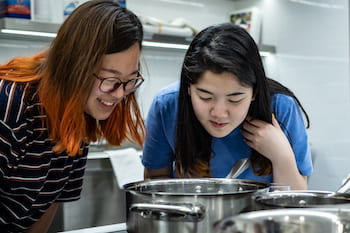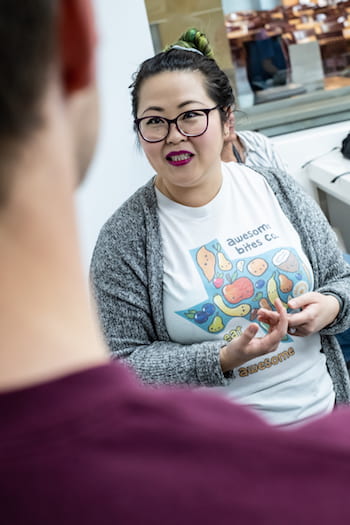Rice freshmen help entrepreneur find the right mix for shelf-stable vegan coconut milk
She had a lovely bunch of coconuts, but what Jennifer Thai really wanted was coconut flaxseed milk. And she got it right, exactly once.
The Rice University alumna and proprietor of Houston’s allergy-friendly Awesome Bites turned to chemistry students for help when her experimental concoction – a vegan coconut flaxseed milk beloved, she said, by all who tried it – refused to cooperate in the kitchen and separated too quickly for her liking.
“I’m obsessive about how I weigh everything,” Thai said. “I measure every single step! And I repeat the steps in the exact same way! And there’s only so many ingredients.”
Her first batch separated in an acceptable-if-not-ideal seven days, she said.
“The second time, it separated in one day,” she said. “The next time, it separated in three days. I couldn’t figure it out.”
The freshman honors chemistry laboratory class taught by Rice lecturer Michelle Gilbertson gleefully took on the problem, not only to help Thai but also to learn the process of working in a chemistry lab toward a specific solution, a skill that will stay with them for a lifetime.

Rice freshmen Minjung Kim, left, and So Jeong (Brianna) Lee cook a batch of coconut “mylk” in Rice’s research kitchen. Photo by Jeff Fitlow
Their unusual advantage was knowing from the start that a solution existed at all.
Thai invented a “mylk” (so-called because it’s dairy-free) that she said has the mouth-feel of whole milk but is made with plant-based ingredients of coconut and flaxseed. However, the quick separation prevented it from commercial scaling.
Ideally, Thai said, the product would stay homogenous on the shelf for two weeks to a month. “What’s hard for us right now is that not only will it separate, it will stay separated,” Thai said.
Coconut milk contains lecithin or other emulsifiers to keep the fatty coconut molecules suspended, but they were not an option for Thai.
The semesterlong journey started when Rice graduate student Jordin Metz, a teaching assistant working with the class, encountered Thai at a campus event.

Rice alumna Jennifer Thai asked a class of chemistry students to help figure out why her vegan coconut “mylk” separated so quickly. Photo by Jeff Fitlow
“The Rice Vegan Society brought her in to give a talk and presentation last semester because she’s a Rice alum doing a cool thing in Houston,” Metz said. “Jennifer told her story and I said, ‘Hey, I work with Michelle Gilbertson and we’re looking for a project.’ That started our connection.”
Split into groups, class members took on separate parts of the problem to test the mix of ingredients, how to process them, their acidity and whether to grind the flaxseed in advance. Students were required to strictly follow the scientific method and keep comprehensive notes throughout.
At the end of the semester, they took their ingredients to Rice’s new research kitchen classroom at Martel Hall, where they were able to cook and try their recipes for the first time. (Tasting chemistry-lab experiments is always off-limits, Gilbertson noted.)
So did the students crack the problem?
“In the final presentation, they suggested relatively simple alterations they felt would prolong shelf life,” Gilbertson explained. Those included changing the ratio of flaxseed to coconut and using a metal strainer in the place of cheesecloth.
“There were also suggestions for a future study, including a buffer system to hold the pH (acidity) of the coconut mixture constant,” Gilbertson said. For her part, Thai said the students made suggestions she had come across elsewhere, but she’s now happy to have the scientific justification to back them up.
“This has been a win for me in every possible respect,” she said.

